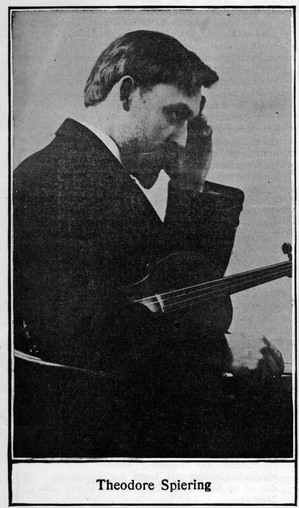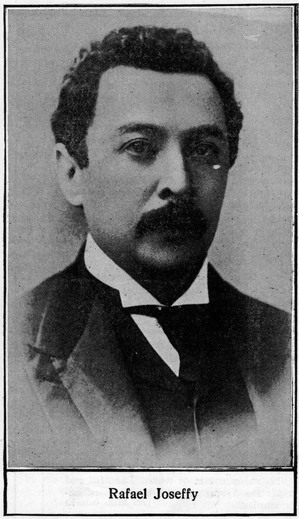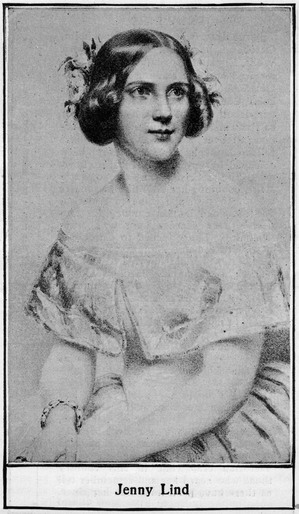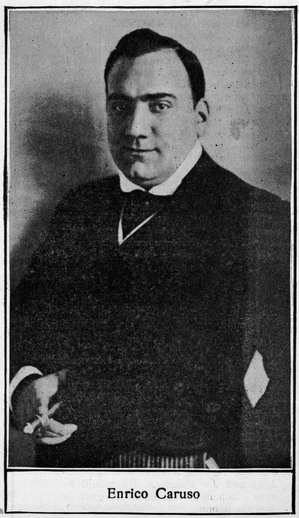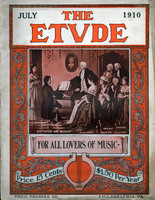Spiering was born at St. Louis, Mo., in 1871, and showed aptitude for the violin at an early age. His first teacher was his father, but in 1886 he was sent to Henry Schradieck in Cincinnati, Ohio. He remained there until 1888, when he went to Berlin and studied at the Royal High School under Dr. Joachim. He had considerable experience in concert work while in Germany, but in 1892, armed with a letter of recommendation from Dr. Joachim, he returned to America, and became a member of the Thomas Orchestra in Chicago. While in Chicago he founded the Spiering String Quartet, which made prolonged tours through the United States and Canada. In 1898 Spiering became instructor of the violin in the Chicago Conservatory, at the time Godowski was head of the piano department. The following year, however, he became director of the Spiering Violin School, giving this up in 1902 to become head of the violin instructors at the Chicago Musical College, and also one of the musical directors. Spiering has made frequent journeys over to Europe, and for a time settled in Berlin as a violin teacher. His work has also won a considerable reputation for him in London. At present he is concertmeister of the Philharmonic Orchestra in New York. As a teacher no less than as a virtuoso, Theodore Spiering has won a very good reputation, his teaching studies and methods having all been highly endorsed by both Fritz Kreisler and Henri Marteau.
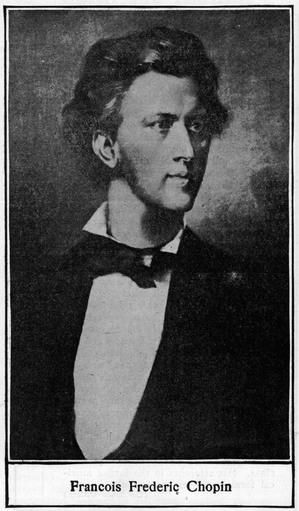 FRANCOIS FREDERIC CHOPIN.
FRANCOIS FREDERIC CHOPIN.
(Sho’-pang, last syllable nasal.)
Chopin was born at Zelazowa Wola, near Warsaw, Poland, March 1, 1809, and died in Paris, October 17, 1849. His teachers were Adalbert Zwyny and Elsner, and quite early in life Chopin made it clear that he was a genius. After making a tour of the chief European cities, achieving a notable success in Vienna, Chopin went to Paris in 1831, where, contrary to his expectations, he remained for the greater part of his life, leaving it only in vain searches for health. It was the Paris of the second Empire, and Chopin was not the least distinguished of a remarkable group of personalities which included Cherubini, Bellini, Meyerbeer, Franz Liszt and Mendelssohn. This notable circle also included George Sand, the woman who brought Chopin so much happiness and so much misery. Chopin possessed a remarkable personality, which seemed to fascinate people to an astonishing extent. He hated crowds, loving only to play to a limited and appreciative audience. Field called him “a genius of the sick chamber,” and his life-long illness, poetic musical genius and intense sympathy with the sorrows and aspirations of his native land served to make of Chopin a musical wizard the like of which will never be seen on earth again. His nocturnes, mazurkas, impromptus, etudes, ballades and piano pieces are unapproached in their class. His attempts in the larger musical forms were less successful.
Joseffy was born at Hungfalu, Hungary, July 3, 1852. Like most musicians, he showed his talent early in life, and commenced his studies on the pianoforte in his eighth year. He studied in Budapest, and with Wenzel at Leipsic, going on to Berlin, where he studied with Tausig for two years. In 1870 he became a pupil of Franz Liszt in Weimar, where he spent two summers. He made his first public appearance in Berlin, 1872, and was markedly successful. A tour through various European capitals followed, and these only served to confirm the verdict of Berlin. In 1879 he came to America, where he has been abnormally successful. His New York debut was made with an orchestra under Dr. Damrosch. Grove’s dictionary says of Joseffy: “With advancing years his artistic nature has ripened and deepened and he has put his transcendental technical powers at the service of a richer and mellower musical style. The breadth and catholicity of his taste and his wide sympathy with diverse schools have always been notable, and he plays Mozart, Beethoven, Schubert, Schumann, Chopin, Liszt and Brahms with equal devotion.” As a composer Joseffy has not written anything of lasting importance. Pianists, however, are fond of his salon music of which The Mill and At the Spring are the best known examples.
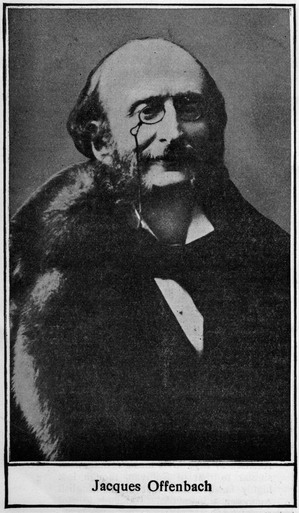 JACQUES (Originally Levi) OFFENBACH.
JACQUES (Originally Levi) OFFENBACH.
(Of’-fen-bahch, final ch guttural.)
Offenbach was born at Offenbach-on- Main, June 21, 1819. He was the son of the cantor of the Jewish synagogue at Cologne, but came to Paris in his youth. In 1833 he studied the cello under Vaslin at the Conservatoire, but showed no taste for study. Next he became a member of the orchestra of the Opera-Comique, where he picked up a great deal of musical knowledge. He wrote some songs at this time which brought him to public notice, and he became conductor at the Theatre Francaise, and composed the Chanson de Fortunio in Alfred de Musset’s Chandelier. Offenbach was not a man of much learning, but he had a pretty wit. He composed upwards of ninety pieces, mostly light operas in twenty-five years. He had a great gift of melody, a notable example of which is the Barcarolle in Les Contes d’Hoffmann. This melody has become very popular of late since the revival of that opera. The Grand Duchess is perhaps the only other of his numerous works which is ever heard complete nowadays. He died from gout of the heart in Paris, not living to witness the first performance of Les Contes d’Hoffmann, which he regarded as his chief work. Offenbach was a composer who added much to the gaiety of nations. He visited America in 1875. His music is somewhat similar to that of Sullivan, though less highly finished than that of the English composer.
Jenny Lind was born at Stockholm, October 6, 1820, and died at Malvern Wells, England, November 2, 1887. She received her first training at the Operatic School connected with the Stockholm Court Theatre, where she made her debut, in 1838. In 1841 she went to Paris and studied under Garcia. Success all over Europe and in England followed, such as has rarely been achieved by any artist. In 1849, however, she retired from the operatic stage, confining her attention to concert work. In 1850 she came to America, and remained in this country for two years. Her success here was overwhelming. She returned to Europe in 1852 with a balance of $150,000, two-thirds of which she devoted to benevolent institutions in Sweden. While in Boston she married Otto Goldschmidt, who had acted as her accompanist. After a long stay in Dresden, Germany, Jenny Lind-Goldschmidt returned to London, and in 1883 taught singing at the Royal College of Music. Her last noteworthy public appearance was at the Rhenish’ Musical Festival, Dusseldorf, in her husband’s oratorio, Ruth (1870). Perhaps the world never had a sweeter singer than Jenny Lind, nor one who gave so freely of her time, ability and money to the cause of charity. In England her name is revered as one of the greatest figures of the Victorian era, while in this country those who heard her and remember tell us there have been none like her since.
Caruso was born at Naples about 1874. He was originally apprenticed to a mechanic, and while his mother was living he stuck to his trade, at the same time singing for his own edification. He earned his first salary as a singer in a church choir at 20 cents a Sunday. On the death of his mother he gave up his mechanical studies, against his father’s will, and earned a living as best he could by his voice. He had very few lessons, though Vergine taught him for a time, until he was called out for military service. He made his operatic début at the Teatro Nuovo, Naples, without a great success, however, and it was not until he appeared in Milan at the Teatro Liroco, in 1898, that he achieved anything of a reputation. He was next heard in South America, where he at once became a great favorite. A success in Puccini’s La Boheme followed, and he was then offered a London engagement. His success at Covent Garden was a triumph, which he duplicated on his first appearance in New York in 1905. He was with the Metropolitan Company in San Francisco at the time of the earthquake. At the present time Caruso holds a unique position among operatic singers. It may be said, in fact, that with many people to go to the opera means to go to hear Caruso. He is at his best in Italian opera of the modern kind, such as Madama Butterfly and La Boheme. He would be very much out of place in Wagner or Strauss opera.


